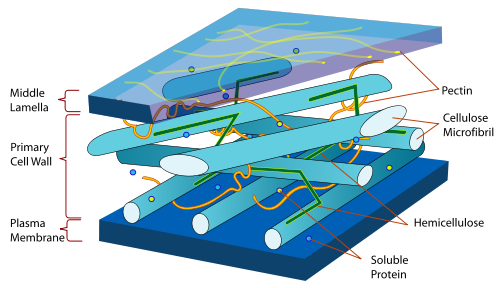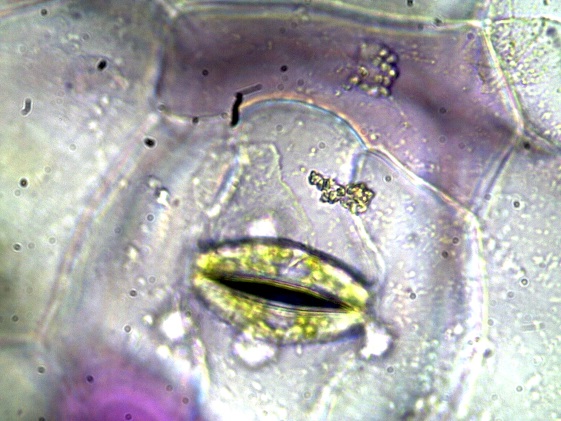
Adaptations
Life is not easy out in the wild. Convallaria majalis cannot escape from its predators or move to find nutrients. It needs support against whatever elements it may face. However, the crucial adaptations that it has takes all of these problems into account and deals with them. I have sorted these adaptations according to what problems they solve for Lily of the Valley.
Escaping Predation:
Toxins
Convallaria majalis is fixed in one location;
in large part due to having cell walls (which will discussed
next). With out being able to run,  leap, or hide from
predators, something must be in
place to prevent this plant from being consumed. This something
just so happens to be toxins. And not measly
toxins that might make you feel a little sick; these toxins are
deadly heart-stopping killers. All three of these toxins are
actually found within the large central vacuole of the plant (Loffelhardt,
Koops & Kubelka, 1979)There are three poisonous
molecules found in all parts of the plant and they are all
considered
cardiac glycosides (Szczawinski & Turner, 1991).
leap, or hide from
predators, something must be in
place to prevent this plant from being consumed. This something
just so happens to be toxins. And not measly
toxins that might make you feel a little sick; these toxins are
deadly heart-stopping killers. All three of these toxins are
actually found within the large central vacuole of the plant (Loffelhardt,
Koops & Kubelka, 1979)There are three poisonous
molecules found in all parts of the plant and they are all
considered
cardiac glycosides (Szczawinski & Turner, 1991).
Epop, Wikimedia Commons, 2008.
These
cardiac glycosides disrupt the sodium-potassium adeninetriphophate pump, or the Na+/K+
pump, which aids in the electrical function and nerve firing
within the heart and other parts of the body (Lofton, 2005).
These three toxins are convallotoxin, convallarin and
convallamarin. Each one has a slightly different chemical
makeup, but convallotoxin is the most harmful. Out of the
naturally produced substances toxins that affect the heart, it
is thought to be one of the most toxic (Szczawinski & Turner,
1991). The chemical structure of convallotoxin is found above
right. Directly below is the chemical structure of convallamarin.
 When any of these three toxins are consumed by any
mammal, the
toxins can cause a cornucopia of symptoms. The following, in
approximate order of severity, are the most typical symptoms of
digitalis-like cardiac glycoside poisoning:
Feeling hot and flushed, headache, nausea, vomiting, burning
in
When any of these three toxins are consumed by any
mammal, the
toxins can cause a cornucopia of symptoms. The following, in
approximate order of severity, are the most typical symptoms of
digitalis-like cardiac glycoside poisoning:
Feeling hot and flushed, headache, nausea, vomiting, burning
in
mouth and throat, diarrhea,
increased saliva production, dilated pupils, abdominal pain,
cramping, clammy skin, irregular slow heartbeat, coma, and death (Szczawinski
& Turner, 1991). It is important to remember that every part of the
plant is poisonous. If the plant is cut and placed in water, the
water can also be toxic and dangerous to drink.
Side Note: Convallotoxin and Medicine
Convallotoxin is not all danger and death. Before the use of
Foxglove, another plant that has deadly cardiac glycosides, convallotoxin from Convallaria majalis was used
medicinally. It was used as a heart stimulant, in a very small
amount. However, doctors also used it as a diuretic. Like stated
earlier, it has now been replaced with toxins from
Foxglove (Szczawinski
& Turner, 1991).
When convallotoxin in ingested in large amounts, like the amount one
would ingest if they took a bite out of Convallaria majalis,
it is extremely harmful. There are a few treatments that a physician
might apply after an individual ingests any of the Lily of the
Valley toxins; forcing vomiting or a gastric lavage may be necessary
depending on how soon the individual begins to show symptoms (Arena
& Hardin, 1974). If they are caught early, this is one of the most
effective means of getting rid of the toxins.
Although this plant looks harmless, its extremely toxic adaptation is deadly. But do not think of these cardiac glycosides as the bad guys here! Without them, animals would likely consume Convallaria majalis into extinction, and we would no longer be able to enjoy there immense beauty. So really, we should be thanking these poisonous molecules.
Support: Cell Walls
Since many plants are stationary, they must have a
mechanism in place to prevent them from being fragile, easily
damaged, and unsupported. One of the adaptations is a cell
wall surrounding the plasma membrane of all the individual cells.
This cell wall is composed of strands of cellulose intertwining and
overlapping.
 What these abundant cellulose fibers result in is a
rigid outer covering around each cell that still allows for the
exchange of materials in and out of the cell. This feature is unique
to plants. Although fungi also posses cell walls, they are
made up of a different material, chitin. The
walls of every individual cell with in the plant makes for a sound
support system within the plant. Depending on what type of cell, the
cell wall can be thicker or thinner, and there may even be a
secondary cell wall, which is located interior to the primary cell
wall if present.
What these abundant cellulose fibers result in is a
rigid outer covering around each cell that still allows for the
exchange of materials in and out of the cell. This feature is unique
to plants. Although fungi also posses cell walls, they are
made up of a different material, chitin. The
walls of every individual cell with in the plant makes for a sound
support system within the plant. Depending on what type of cell, the
cell wall can be thicker or thinner, and there may even be a
secondary cell wall, which is located interior to the primary cell
wall if present.
LadyofHats, Wikimedia Commons, 2007.
Gas Exchange: Stomata
Based on the formula of
photosynthesis, we know that oxygen in released as a waste
product, but carbon dioxide is needed as well. But how does this
oxygen leave the leaf? How does the carbon dioxide enter the leaf?
There are special structures located on the leaves called stomata.
They are small openings that allow for exchange of gases that can
open or close based on if the plant needs to release or take in
gases. They consist of two cells called guard cells that are
responsible for the opening and closing of the stomata. The process
revolves once again around osmosis and material moving and in and
out of these guard cells. When the guard cells are turgid, or full
of water and there is lots of internal pressure, the stomata will be
open. However, when the water exits these cells, the cells lose that
internal pressure and close. The result is the efficient exchange of
gases within the leaves on Convallaria majalis. On the
bottom left there is an example of an open stomata, and on the right
is a closed stomata.


Brett Pickarts, sent via e-mail, 2013.
Brett Pickarts, sent via e-mail, 2013.
Water Uptake: Roots
Convallaria majalis has to get the water for
photosynthesis from somewhere... but
where? The simple answer is the roots. But the process involved a
little more than that. It involves a little bit more help, help from
interactions with other species. The
soil is the source of water for the plant, and the roots are
responsible for helping take in this water. The water will
eventually have to travel up to the leaves... but how?!
Water and Sugar Movement: Xylem and Phloem
How do plants manage to evenly distribute water as well as
sugars across the entire plant? Based on Convallaria majalis's
nutrition, we know that sugars are made
within the leaves. The water found within the ground is taken up by
the roots of the plant along with many nutrients (some
other species assist in this exchange
as well). What we end up with is plenty of water within the roots
and a lack of sugar. The leaves have a lack of water and an
abundance of sugars. The adaptation set up to deal with this problem is a
vascular system. The vascular system consists of two main
components: the xylem and the phloem. The difference between these
two is the way in which they carry their respective substances. The
xylem carries water and nutrients up to the leaves from the roots
while the phloem carries sugars down to the roots from the leaves. They are both
skinny mostly hollow pathways that allow molecules to flow within them.
Each one is equally important for the survival of the plant.
This still leaves us with the question of how the materials actually travel. The most basic concept behind both is osmosis. Where ever water is less abundant, water will travel there from a place where it is more abundant. A few properties of water help with the movement of the molecules up and down the vascular system. Cohesion, the ability of water to stick to itself, adhesion, water's tendency to stick to surfaces, and capillary action, or the tendency of water to be sucked up when stuck in a closed tube.
In terms of xylem's water movement, it is important to understand transpiration. Transpiration is the evaporation of water out of the leaves, typically in the form of water vapor leaving the stomata. When transpiration occurs, there is an increased sugar concentration within these leaves. With this increased solute concentration within the leaves, a negative pressure is created within the xylem. The reduced pressure within allows water to travel up the stem or body of the plant all the way up to the leaves. The cells that create the continuous tube of the xylem are called the vessel members, which are actually dead at maturity!
Phloem movement cannot rely on transpiration, but it still can use diffusion. First, sucrose enters the cells of the phloem, the sieve tube members, via active transport, meaning energy must be invested into this movement. Active transport is necessary to move molecules against the rules of osmosis, which would be the case here, since sugars are already in high concentration within the sieve tube members. Now that there is a high concentration of sugars within the sieve members, there is a low concentration of water. This means that water will enter this cells via osmosis. Now picture all of these molecules inside of this small closed portion of a tube. This creates an area of high pressure formed in the leaves. Now due to the lack to sugar, and therefore lack of water within the roots, there is low pressure at the roots. The sugar and water will flow from areas of high pressure to low pressure, meaning the sugars will flow from the leaves to the roots. The roots are in need of the sugar, and in order to maintain the pressure system, the sugar must be constantly added at the top and drained from the bottom.

Since Lily of the Valley is a monocot, the vascular bundles, or packages of xylem and phloem, are scattered through out the stem randomly. These bundles can be seen on the right. The oval, almost face-like structures are the bundles. Notice the random pattern here! Because of this arrangement, monocots are unable to grow in girth, but only in height. Due to this inability to grow in girth (secondary growth), it places a limit on how much primary, or upward, growth can occur. If the plant becomes too tall, the skinny stem will be unable to fully support the plant.
BlueRidgeKittens, Flickr, 2010.
Reproduction:
Rhizomes
The majority of reproduction within Lily of the Valley
takes place via structures called rhizomes. The rhizomes are an extension of the roots within
Convallaria majalis. The rhizomes actually begin their
growth like the roots. The rhizomes are essentially similar to
roots, but they store many more nutrients and proteins for the plant
to use. The rhizomes push through the dirt through growing by mitosis. These
rhizomes will grow fairly parallel to the ground, reaching out to
find another place for a stem to germinate. When the rhizome detects
that the spot has enough nutrients, it will begin to grow a new stem
off of the rhizome. The entire process is that simple! However, it is
important to note that due to this type of growth, usually called clonal, there is no difference in the genotypes among the plants (Vandepitte
et al, 2010). See where rhizomes fit within the
life cycle of Convallaria majalis.

Margaret Warren, Margaret's Garden, 201o.
Protection from Disease:
Divinyl ether synthase (DES)
Here is an exciting extra for you! There was a study
done to test for the presence of a certain chemical within plants.
The chemical is called divinyl ether synthase, or DES. It is not
frequently found, but it is almost unheard of to find this special
disease fighting substance within a monocot. Prior to the study,
only one other monocot was known to have DES. However, the study
revealed that Convallaria majalis does indeed have DES (Grechkin, Latypova,
Mukhtarova, & Ogorodnikova, 2008). What does this mean for the
plant? Having DES helps fight plant diseases with much less time and
difficulty. This adaptation is thought to be part of the reason why
Lily of the Valley is such a persistent plant, even when other
plants struggle to maintain their lifestyles.
The nutrition page can help explain why some of these adaptations are necessary!